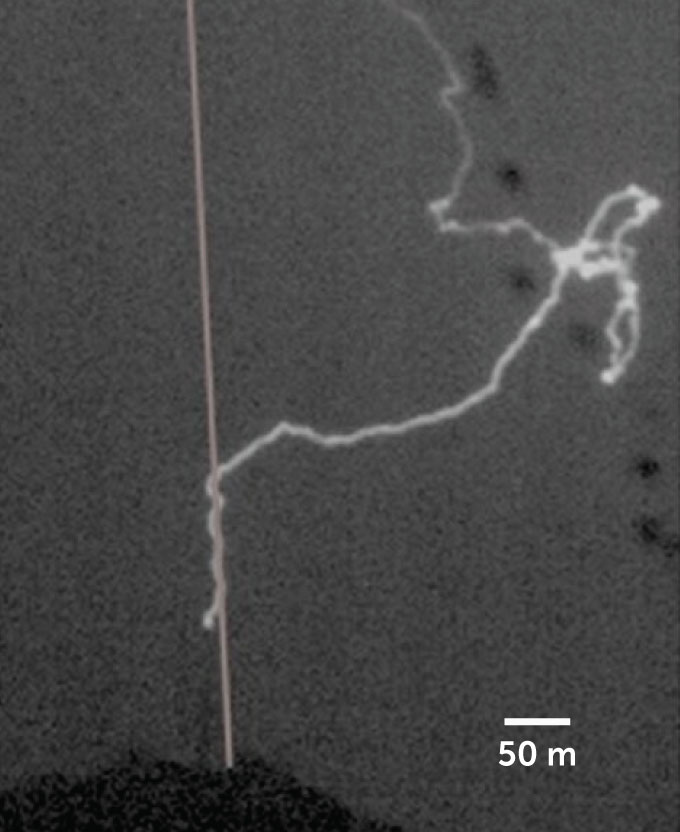Like a high-tech hammer of Thor, a powerful laser can grab hold of a lightning bolt and reroute its path through the sky.
In a mountaintop experiment, such a laser bent lightning toward a lightning rod, researchers report online January 16 in Nature Photonics. Scientists have used lasers to wrangle electricity in the lab before, but this is the first demonstration that the technique works in real-world storms and could someday lead to better protection against lightning.
Science News headlines, in your inbox
Headlines and summaries of the latest Science News articles, delivered to your email inbox every Thursday.
Thank you for signing up!
There was a problem signing you up.
Today’s most common anti-lightning tech is the classic lightning rod, a meters-long metal pole rooted to the ground. The metal’s conductivity lures in lightning that might otherwise strike nearby buildings or people, feeding that electricity safely into the earth. But the area shielded by a lightning rod is limited by the rod’s height.
“If you want to protect some large infrastructure, like an airport or a launching pad for rockets or a wind farm … then you would need, for good protection, a lightning rod of kilometer size, or hundreds of meters,” says Aurélien Houard, a physicist at Institut Polytechnique de Paris in Palaiseau, France. Such a tall metal pole would be impractical. But a laser could reach that far, intercepting distant lightning bolts and ushering them down to ground-based metal rods.
Houard and his colleagues tested this idea atop the Säntis mountain in northeastern Switzerland. They set up a high-power laser near a telecommunications tower tipped with a lightning rod that is struck by lightning around 100 times every year. The laser was beamed at the sky for about six hours total during thunderstorms from July to September 2021.
The laser blasted short, intense bursts of infrared light at the clouds about 1,000 times per second. This train of light pulses ripped electrons off air molecules and knocked some air molecules out of its way, carving out a channel of low-density, charged plasma. Sort of like clearing a path through the woods and laying down pavement, this combination of effects made it easier for electric current to flow along this route (SN: 3/5/14). That created a path of least resistance for lightning to follow through the sky.
Houard’s team tuned their laser so that it formed this electrically conductive pathway just above the tip of the tower. This allowed the tower’s lightning rod to intercept a bolt snagged by the laser before it zipped all the way down to the laser equipment.
The tower was hit by lightning four times while the laser was on. One of those strikes happened in a fairly clear sky, allowing two high-speed cameras to capture the moment. Those images showed lightning zigzagging down from the clouds and following the laser light for some 50 meters toward the tower’s lightning rod.
Subscribe to Science News
Get great science journalism, from the most trusted source, delivered to your doorstep.
To track the paths of the three bolts that they could not see, the researchers looked at radio waves shed by the lightning. Those radio waves showed that the three strikes followed the path of the laser much more closely than other strikes that happened when the laser was off. This hinted that the laser guided these three strikes to the lightning rod, as well.
“It’s a real achievement,” says Howard Milchberg, a physicist at the University of Maryland in College Park not involved in the work. “People have been trying to do this for many years.” Scientists’ main goal in bending lightning to their will is to increase safety, he says. But “if this thing ever became really, really efficient, and the probability of guiding a discharge was increased way beyond what it is now, it could potentially even be useful for charging things up.”
Atmospheric and space scientist Robert Holzworth is more cautious about imagining the applications. “They only showed 50 meters of [guiding] length, and most lightning channels are kilometers long,” says Holzworth, of the University of Washington in Seattle. So scaling the laser system up to have a useful reach may take a lot of work.
Using a higher-frequency, higher-energy laser could extend its reach, Houard says. “This is a first step toward a kilometric-range lightning rod.”


